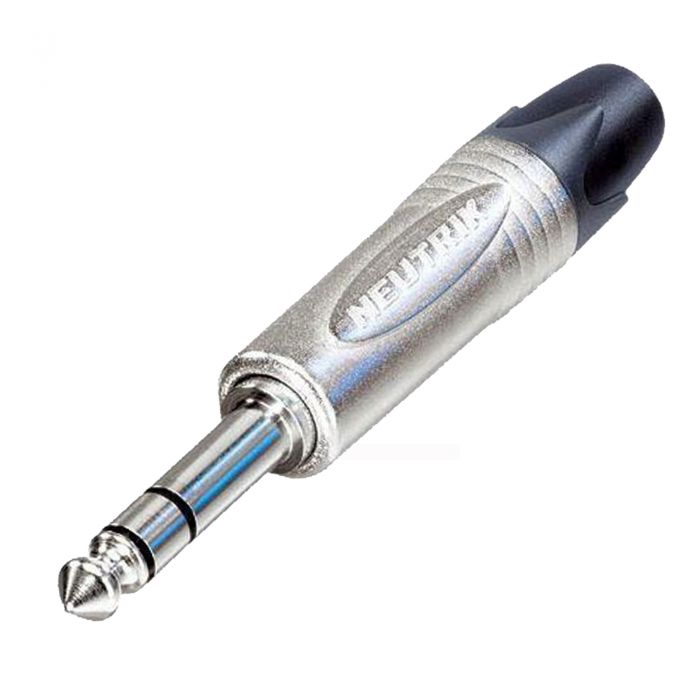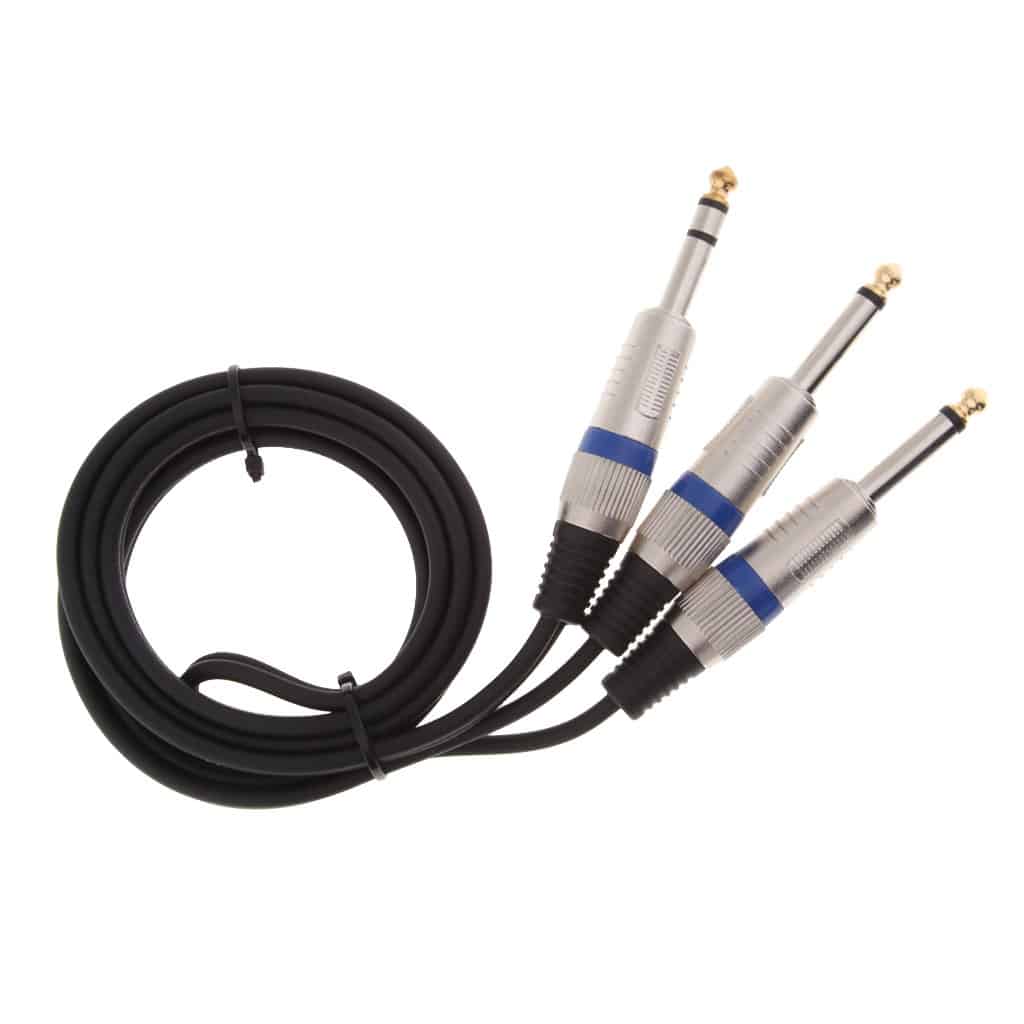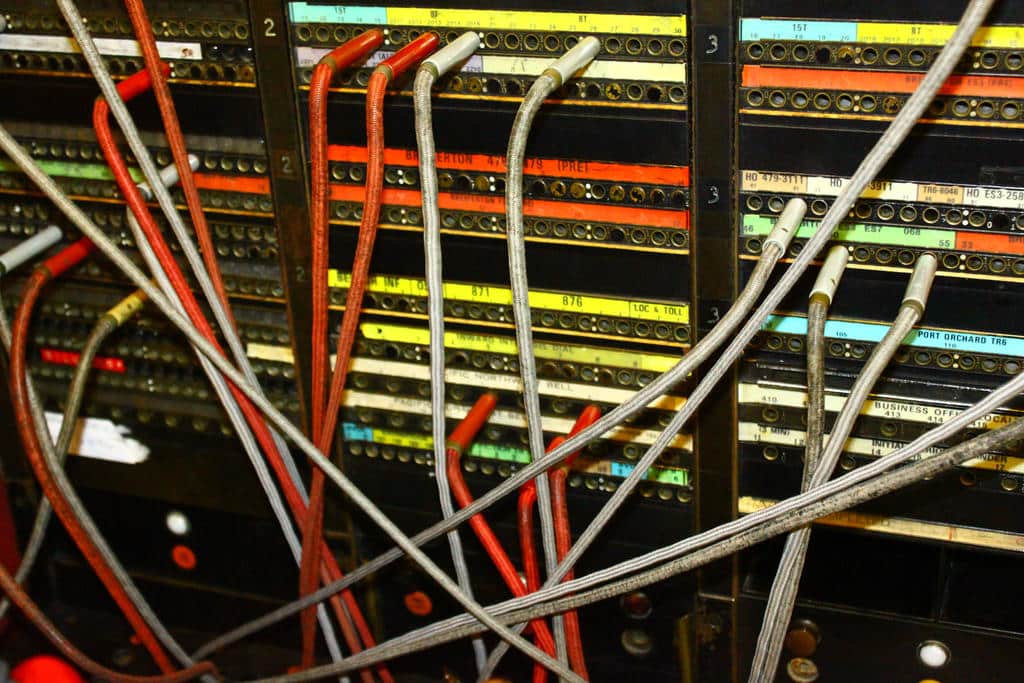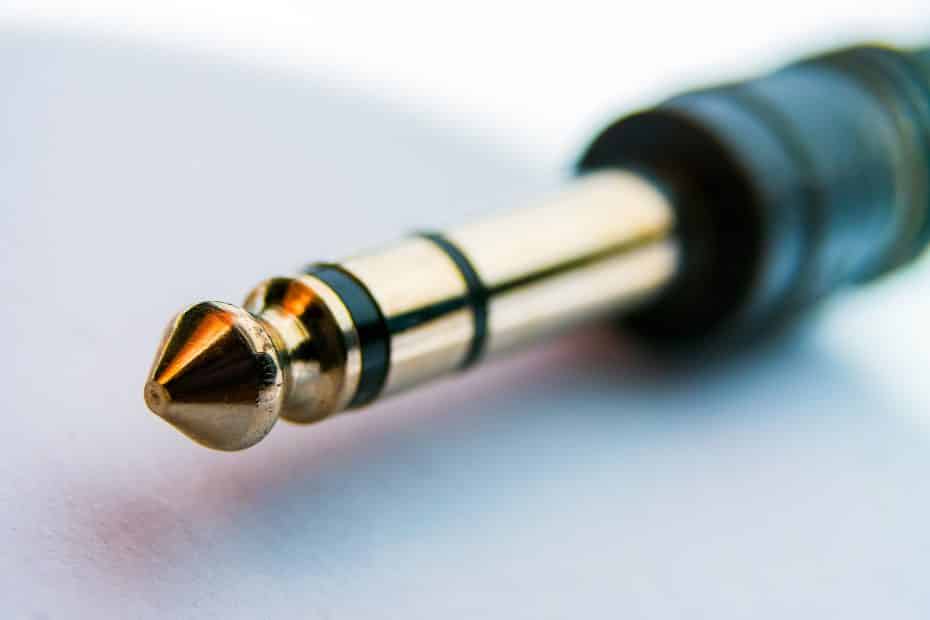Pro-Audio devices sometimes call for TRS cables. What are these, and why do they frequently cause confusion? Let’s find out.
The letters TRS stand for Tip, Ring, and Sleeve, and refer to the parts of the jack plug that the different conductors are connected to. A TRS cable has three conductors vs the two on a standard guitar cable. A guitar cable is a TS, or Tip Sleeve cable.

The jack plug at the top is a TS jack. The pointed metal bit at the end, is the tip, and the long metal shaft is the sleeve. The black band between them is an insulator preventing the two parts of the jack from shorting together. Notice we said ‘band’ and not ‘ring’. It’s easy to look at a TS jack and assume the black insulation ring is the ‘R’ in TRS but it’s not. The TRS jack is at the bottom. It has a metal ring in the middle which is the third conductor. The three conductors are separated by two black insulation bands.

There are other types, most commonly a TRRS which has two rings, and four conductors in total. TRRS jacks are often used for stereo headsets with microphones where four conductors are needed for ground, left channel, right channel, and mic.
A TS cable is fine for carrying a mono instrument signal such as from a guitar pickup to amp. The tip carries the signal and the sleeve is the return path and also usually the ground. Sometimes an additional conductor is needed such as for carrying a stereo signal, a balanced signal, or when connecting a voltage divider such as in an expression pedal. When a device requires a TRS cable, it’s because the application needs a third wire, and it will normally not work correctly if you try to use a TS cable in it’s place.
When we refer to a TRS cable, it normally means that there is a TRS jack at both ends. However, there is also another variant called a TRS Insert cable or TRS Y cable.

The insert cable has a TRS jack plug on one end and two TS jack plugs on the other. They are called insert cables because they are often used in recording studios to connect outboard equipment to insert points on a mixer. They can also be used to connect stereo signals between equipment where device A uses separate jacks for left and right channels, and device B uses a combined TRS jack.
Like regular TS cables, TRS cables come with different jack plug sizes. The most common in pro-audio is the 1/4″ jack. The outside diameter at the sleeve is 1/4″. These are sometimes also called phone jacks, since they originated in the 19th Century for use in the first manual telephone switchboards. Wikipedia suggests that the 1/4″ jack may well be the oldest type of electrical connector still in widespread use having begun its life in 1878.

The smaller jacks commonly used are 3.5mm for computers and 2.5mm for handheld devices. Since much of the world had switched to the metric system by the time these smaller jacks were created, we now have to deal with the mixed units of measurement of the 1/4″ phone jack from the 1800’s and the modern metric computer audio plug.
A 1/4″ jack is 6.35mm
A 3.5mm jack is approx 1/8″
A 2.5mm jack is approx 3/32″
So, what about balanced cables, are TRS cables balanced or not? In short, no, the cables themselves are not balanced, they are simply cables with three conductors, it’s the interfaces that determine if a connection is balanced or unbalanced (single-ended). However, a TRS cable may be required to use a balanced connection. A balanced interface normally has three wires:
1. Reference (usually ground)
2. Signal (hot)
3. Inverse (cold)
A balanced connection can help reduce noise from electromagnetic interference by using a technique that sends two copies of a signal 180 degrees out of phase with each other. There’s a more complete explanation of how balanced interfaces work here
For a balancing to work, the equipment you are connecting, must have a balanced interface. If it does, then you’ll need to use a three-wire cable. Often balanced connections use an XLR cable but sometimes, 1/4″ TRS cables are used instead. We may see TRS cables referred to as balanced cables for this reason, but it’s a bit misleading because it’s not the cables that are balanced. Sure, you may need TRS cables to connect two balanced devices together, but just using a TRS cable to connect two single ended devices together will NOT turn it into a balanced connection.
In conclusion, a TRS cable is a cable with round phone type connectors and three conductors called tip, ring and sleeve. The jack plugs maybe different sizes, so check you have the correct size for your gear. The cables can be used for different applications such as a stereo connection (right/left/ground), a balanced connection (hot/cold/ground), or a voltage divider connection (input/output/ground). However, the cable itself is the same.
If you need a TRS cable for your rig, check out Mission cables here.

Thanks for the info! It seems like I should have known all of this,and I actually did,but now they’re calling it something else! I would like to know if I could use a TRS Insert cable to run to 2 different amps? Thanks for the great products,I only wish I had some money!! Cheers!
If you are looking to take a mono signal (like from a regular guitar pickup) and split it into two signals to send to two amps, you need a device called and ABY box. Like this:http://www.radialeng.com/r2011/bigshotaby.php
hi just onto expression pedal. have stomp box which has mono output Line6 M5 ,stated as use ts cable. however looking to get expression pedal ME urs brand or EHM and they are stated as trs cable required. any idea how to connect or is there trs one side sigle jack ts other side single jack version ?. thanks
I understand the function of a TRS cable for connecting stereo to mono (I have that with my accordion, where the left and right side signals come out on and TRS jack, and split to 2 mono cables.
What else is it used for? Is it used for the same function as XLR, where you have ground and signal / mirror image of signal, to eliminate interference? If so, is it in any way an improvement over XLR?
thanks
TRS can be used for balanced signal similar to XLR. They can be used for stereo signals, (like in stereo headphones). They can also be used in other applications where three conductors are required such as when used as a voltage divider with expression pedals, a mono earpiece and mic, or mixing signal and power such as powering active pickups.
Great info. Thank you. I’m having a hard time finding info on what line 6 calls a “sleeve to short” cable that’s to be used to switch channels on an amplifier. My amp (a Fuchs ODS) uses aTRS cable. When I tried connecting the Line 6 hx effect to the Fuchs to change channels I get a terrible feedback.
What is sleeve to short and is there a way to make the line 6 and Fuchs compatible? Thank you
Great Info:
However, I have a problem. I am trying to connect my mic to my DBX 286S but is ending up with a hum and the signal becoming extremely hot in terms of volume and play back.
I am wondering if my 1/4″ jack is the problem or my XLR?
Thank for any help in setting this stuff up.
Im not that familiar with the DBX, but it looks like it’s only MIC input is the XLR jack and it’s 1/4 TRS is a line level input. Don’t connect a mic directly to the Line level input. You should only connect a mic to the XLR mic input. If you are using a high impedance mic, you’ll also need to use an impedance matching device between the mic and the input.
You should have gone a step further to discuss the internal wiring for a TRS cable and how it could be used for additional purposes.
I mean…this is an ENGINEERING topic, is it not?
I’ll help:
Usually, inside a TRS cable, for example, there are the 3 conductors the OP was referring to — L audio, R audio, and ground (shield). The colors can vary between the signal wires (L/R) so it’s important to use a multimeter to test for continuity between each signal wire and the tip (usually the L audio) and the sleeve (usually the R audio). That way, you know you’re making your connections correctly.
Correction — the RING is usually R audio, not the Sleeve. The SLEEVE is usually ground.
It would be helpful if you could be slightly more patronising. Just a suggestion.
Bill
I am happy I lean a lot thank you
If a stompbox has stereo outputs where the R output can be mono to send to a guitar amp, will the left output (TRS) alone send a stereo signal to a PA so it will come out stereo or would it only be 1 of the stereo channels instead of both? This would be a setup where stereo keys and mono guitar are plugged into the stompbox. The idea would be to send separate signals (1 mono and 1 stereo) to separate amp sources.
I am connecting a Roland FA-08 keyboard toa Scarlett 18i8 interface. (previously I had a Roland Juno DS which worked fine with this setup.
I now have a hum when the interface is powered on.
THIS keyboard requires TRS cables to the interface. Would using non-TRS cables cause a hum?
Thanks!
Two questions…
1. Stereo outs of a Nord/Spdsx to 1 channel of an audio interface on to a Stereo Channel in the DAW using a Insert/Y Cable would still give me the stereo image?
2. Studio Monitors – the interface had Jack outs. The KRK Rokits have both Stereo & Jack inputs. What would be my best cable?
Wonderful information, thanks a lot for sharing kind of content with us. Your blog gives the best and the most interesting information. I wonder if we can gather such practical information about what is a Trs cable Great one!!If you are looking same kind of valuable information, then can also visit Mitchellelectrical.nz
Very useful information, even though I’ve worked with audio equipment for years. I knew about conductors and such, but didn’t know what TRS was. Heck, I’ve been using TRS cables for YEARS, not knowing what it stood for. Thank you for this useful info!
From John Nozum
Our pleasure!
I have a 5-CV pedal. This MUST be used with TRS cable for outputting 0 to 5V, right?
The 5CV can be used with either TS or TRS cables and devices
I have a Behringer Poly-D and using TR cables gives an awful hum, and the decibel level is low. For some reason the TRS cable not only corrects that, as expected, it increases the output by enough to notice.
I want to connect 2 receivers together in order to have my music playing in 2 locations simultaneously and I do not listen to AM/FM radio. I usually stream Spotify but I also have a fairly extensive mp3 library. No wireless solutions please! I want a wired connection between the 2 and the run is approx. 75 to 80′. I was told that RCA cables aren’t good for long runs and that I should use balanced cables and possibly even baluns at each end for a good clean signal. I am not savvy in this area so I’m looking for help figuring out exactly what will do this job with the least amount of financial impact.
Hi there,
thanks in advance for your help. I am connecting my headrush MX5 in mono to my FFFR Headrush 112. Currently I am using a guitar cable with is TS. Since I am going out in mono and not stereo to the FFFR speaker should I be using a TRS cable or will just using another guitar cable TS be best to plug into the headrush 112?
Who can build a few simple TRS cables for me?
I need to use something small, like Belden 8451 or the Carrol equiv.
I need to punch down all the gazintas and gozottas from a small analog audio mixer to the building cross-connect network so it will appear in other studios.
I *can* sit around all day making these, or I can try to order them premade, say 6′ length, terminated to Switchcraft 1/4″ TRS (or Neutrik, nothing less reliable than one of those two)
??
Everything I see on line is run with standard mic cable, or speaker cable. I need 28ga or so to work with punchblocks…
You could try Bestronics Pro Audio at https://btpa.com
Just randomly wanted to say I appreciate you explaining what TRS is. I even clicked here from Google just to say that, and so you got the link referral notice. Random, but there we go!
Okay, having got what I wanted I then thought I might was well read the article. I’ve been faffing with audio stuff since I was a teenager, so kinda knew a lot of this or heard bits and pieces, but I just wanted to add – excellently written article. Thank you! 😊
I just wanted to (randomly!) say I appreciate you explaining what TRS is. I even clicked here from Google just to say that, and so you got the link referral notice. Random, but there we go!
—
Ah, only one comment at a time, which is reasonable.
Anyway, after I posted my first comment and having looked up what I wanted to know (what does TRS stand for) I was just about to close the tab, but, instead figured that I might was well read the article now I’m here. I’ve been faffing with audio stuff since I was a teenager, so kinda knew a lot of this or heard bits and pieces, but I just wanted to add – excellently written article. Thank you! 😊